How To Fill A Frigidaire Dishwasher With A Rinsing Agent
Learning to use a new appliance's features and functions properly can take a while, even if the appliance itself is already broadly familiar. That being said, you should take a moment to fill your Frigidaire dishwasher's rinse aid reservoir before you go back to puzzling out the buttons on the panel. It's a relatively simple task but a necessary one.
Why Use Rinsing Agents?
Why Use Rinsing Agents?
A rinsing agent, or rinse aid, is designed to help water slide from your dishes in sheets rather than pooling into drops that can dry in place and leave spots. It also shortens the time, and lessens the electricity needed, to dry your dishes. Your dishwasher is designed around the assumption that you'll use a rinse aid, and it won't work its best when you don't.
Manufacturers typically suggest you use a rinse aid even if your detergent comes in the form of an all-in-one tablet or pod that already includes one. That's because the quantity of rinse aid in a pod or tablet is limited and might not be enough for efficient operation. You can easily judge if that's the case: If your dishes are still wet when the cycle is finished, or if they have visible spotting, you'll need to add a rinsing agent separately.
Dishwasher With a Twist-Type Dispenser
Dishwasher With a Twist-Type Dispenser
You'll find two main types of dispenser in Frigidaire dishwashers, and both are located immediately beside the detergent dispenser. The first type has an enclosed reservoir with a cap that twists to remove. Turn it one-quarter turn counterclockwise to open. Depending on the model, there may be a mark embossed into the reservoir to show the correct position. Turn the lid to that mark and lift it out to remove it.
If you look inside the opening, you'll see a fill line illustrating how much rinse aid to use. Fill the reservoir to that point (approximately 5 ounces if it's completely empty) and then replace the cap. Most models have a narrow gauge built into the reservoir so you can tell at a glance whether it's full or needs topping up.
Dishwasher With a Flip-Top Dispenser
Dishwasher With a Flip-Top Dispenser
The second style of rinse aid dispenser has a smaller reservoir with a cover that flips up for filling. To unlatch it, press down gently on the middle of the lid while simultaneously lifting from the end opposite the hinge where it overhangs the reservoir. Again, you'll find an opening with a clearly marked fill line inside the reservoir. Fill it to that line, then flip the cover closed and press it into place until it clicks.
Adjusting the Rinse Aid Usage
Adjusting the Rinse Aid Usage
The twist-cap reservoir holds enough rinse aid for 35 to 140 loads, and the flip-top dispenser is good for 11 to 66 loads, depending on how much you dispense per cycle. That's usually controlled by a physical dial located on the underside of the cap. Start with a low number, and if you find that your dishes are spotting or not drying adequately, you can increase the number until the problem goes away.
Some models control the dispensing of rinse aid through the front panel instead. In that case, press and hold the Rinse Only button for five seconds until it shows you your current level of rinse aid in the reservoir. Then you can use the Delay Start pad to cycle through the four setting levels.
Rinse Aid Dispenser Won't Fill
Rinse Aid Dispenser Won't Fill
If your rinse aid dispenser won't fill, or more likely won't dispense, it's usually because of a physical buildup of either hard-water scale or detergent and rinse aid. Removing or lifting the cap and carefully scrubbing both the cap and the dispenser will usually clear away detergent or dried-on rinse aid. Mineral deposits from hard water can be removed with a vinegar solution or commercial descaling product.
In some cases, the cap of your rinse aid dispenser may have become damaged through heat or some other cause and may either prevent the rinse aid from dispensing or dispense it too freely. In that case, you can simply order an inexpensive replacement cap to restore normal operation.
